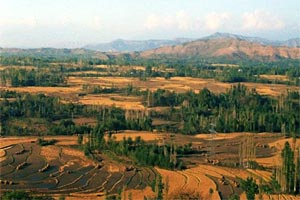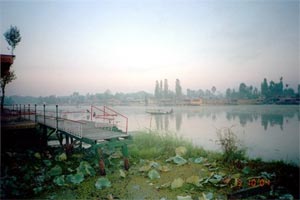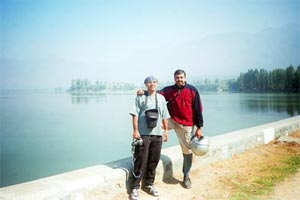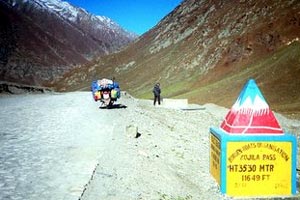|
Kashmir
- The Bliss
I was surprised to have a view of snowy peaks glistening with
morning sun rays from our hotel. Season’s first snow
is already here, we thought, with a twinkle in our eyes. I
tightened the chain by one tooth and serviced the bike. After
a sumptuous breakfast, we were off to Kashmir. Bypassing Jammu
on a picturesque Samba – Udhampur route took us to the
serene waterscape of Mansar Lake. But we had to reach Srinagar
by evening so after crossing Udhampur and negotiating several
hairpin bends we made a steep ascent to the picture-perfect
Patnitop. The place offers cool environs and sylvan landscape
with coniferous trees covering the whole area. One major grouse
of riding on this route was getting stuck in between the Military
Convoys. They grabbed all the road and we almost did not ride
alone at all. Either a Military truck was before or behind
us. We crossed 2.5 km long Jawahar Tunnel at 5:00 pm and had
the first glimpse of Kashmir Valley. Ahoy! We were in Kashmir,
welcomed by riveting scenery of a sprawling valley beckoning
us with mountains stretched far at the horizon.
 To
lech at the scenery I brought the bike to a halt near one
of the Military Jawans. Oh Man! They are standing after every
100 meters on the highway. The ‘Jawans’ informed
us that their breakfast, lunch, dinner and tea (twice) are
delivered to them right there. Responding to my query on the
beefed up security, he narrated a recent incident of militants
on a killing spree. But what we were stunned by was not the
terrorism but the awesome grandeur of the valley with profusion
of color, a gradient mix of brown and green in particular,
and the Chinars, Poplars, Willows dotting the cultivated land. To
lech at the scenery I brought the bike to a halt near one
of the Military Jawans. Oh Man! They are standing after every
100 meters on the highway. The ‘Jawans’ informed
us that their breakfast, lunch, dinner and tea (twice) are
delivered to them right there. Responding to my query on the
beefed up security, he narrated a recent incident of militants
on a killing spree. But what we were stunned by was not the
terrorism but the awesome grandeur of the valley with profusion
of color, a gradient mix of brown and green in particular,
and the Chinars, Poplars, Willows dotting the cultivated land.
Riding at an unhurried pace, we both were enjoying the cool
scenic countryside and the saffron fields of the valley. Suddenly,
on my right, I spotted some ruins. We took a break to check
out. They were the ancient ruins of 9th Century Avantilokeshwara
Temple Complex built by the King Awantivarman. The temple
complex, though in ruins, has not lost its grandeur with two
magnificent, massive temples dedicated to Shiva (Avantiswara)
& Vishnu (Avantivishnu) standing as mute testimonies to
their heydays. While the former has only the plinth and surrounding
staircases left to it, the latter was in a better preserved
state with imposing roofless walls on a high plinth to which
wide staircases lead. We, though, couldn’t find any
statue of the deities. Interestingly, I took four snaps of
the place, including one with me in the frame but all of them
remained underexposed. Strange!
The Srinagar highway from Khannabal is very dusty all through
barring few patches. Commercialization of the land beside
the national highway has deprived the area of its pristine
beauty. As we touched Srinagar, heavy security replaced the
scenery from our minds. At one stretch, as we were about to
enter the city, we were asked to shut off our headlights.
Unlike no one, we complied. It was pitch dark and all the
vehicles were moving with the help of backlights of the vehicles
in their front. Our inceptive euphoria was stifled as we negotiated
the unruly traffic, while dust kept piling on us. This was
far from the Srinagar we imagined. By the time we reached
Dal Gate it was 8:00 pm and we were hungry like beasts. We
decided to scour down a nice houseboat for the night and then
log in to an eating joint. Dal is a beautiful lake and reflections
of distant lights from the water surface gave us a welcome
respite from the city pollution and dust. In fact, it elicited
a magical reaction from both of us and we were off our feet.
We haggled for one dream-home-houseboat for the night and
got a deal. The very next moment saw us onboard a ‘shikara’
rafting towards our magnificent night halt. To our dismay,
like Srinagar city, lake was heavily littered with dirt and
decaying organic matter taking its toll on the cleanliness
of the lake. With the increase in the dumps, lake area is
decreasing at an alarming rate, jeopardizing the lives of
a unique community, economy and beauty of the city.
 Why
a houseboat and not a hotel? Well! As many travelers put it,
“If you have not done houseboat, you have not done Kashmir”.
People residing in houseboats are not only just living on
the water, but they are commuting, selling, buying, drinking,
eating and doing all sorts of mundane things…..on the
water, isn’t that amazing? Not merely! In fact, it is
a unique community who developed due to the excellent network
of erstwhile Vitastha (now Jhelum), waterways and lake system
of the valley. Believe it or not, houseboat dwellers do farming
on the lake. That is a sight to behold with fresh vegetables
floating around and flowers in full bloom. Houseboats flourish
because of their uncommon, serene experience and they provide
business to many associated people like ‘shikara wallahs’,
‘flower wallahs’, ‘chai wallahs’,
‘saffron wallahs’, ‘cloth wallahs’,
so on and so forth. Houseboats can float on the lake but generally
don’t because of their sheer size and since they are
not motorized. They have their moorings down at one location.
These boathouses have ritzy interiors and are richly embellished
from inside. Elaborately carved wood, sweet dim light and
all the luxury (refrigerator, TV, etc.) in-house, they provide
quite a royal experience. It takes around 24 months of hard
labour to build one houseboat, which actually amounts to around
four years, keeping in mind only six month’s working
season. Our houseboat, built at a cost of Rs. 25 lacs, made
quite an impression on our minds. Settling down in our plush
room after a ‘shikara’ ride for the dinner, we
discussed about our ride so far. Later, while snoring to each
other, we dreamt about the wonderland, the Ladakh. Why
a houseboat and not a hotel? Well! As many travelers put it,
“If you have not done houseboat, you have not done Kashmir”.
People residing in houseboats are not only just living on
the water, but they are commuting, selling, buying, drinking,
eating and doing all sorts of mundane things…..on the
water, isn’t that amazing? Not merely! In fact, it is
a unique community who developed due to the excellent network
of erstwhile Vitastha (now Jhelum), waterways and lake system
of the valley. Believe it or not, houseboat dwellers do farming
on the lake. That is a sight to behold with fresh vegetables
floating around and flowers in full bloom. Houseboats flourish
because of their uncommon, serene experience and they provide
business to many associated people like ‘shikara wallahs’,
‘flower wallahs’, ‘chai wallahs’,
‘saffron wallahs’, ‘cloth wallahs’,
so on and so forth. Houseboats can float on the lake but generally
don’t because of their sheer size and since they are
not motorized. They have their moorings down at one location.
These boathouses have ritzy interiors and are richly embellished
from inside. Elaborately carved wood, sweet dim light and
all the luxury (refrigerator, TV, etc.) in-house, they provide
quite a royal experience. It takes around 24 months of hard
labour to build one houseboat, which actually amounts to around
four years, keeping in mind only six month’s working
season. Our houseboat, built at a cost of Rs. 25 lacs, made
quite an impression on our minds. Settling down in our plush
room after a ‘shikara’ ride for the dinner, we
discussed about our ride so far. Later, while snoring to each
other, we dreamt about the wonderland, the Ladakh.
 We
both rose early to capture some morning reflections, activities
and of course, the sunrise. As the early morning mist vaporized,
we were gifted with some stunning views. Morning sun appeared
in all its glory setting ablaze the ‘char chinars’
in a heavenly aqua-setting. We couldn’t leave the quasi-deck
of the boat, while ‘shikaras’ of all sorts and
loaded with all sorts of stuff engaged in their routine up-down
‘voyages’. Our cameras kept clicking till we realized
we were past 15 shots (cumulative count). So! It was time
to leave…..leave our beautiful home…..home on
the water. One night stay in the houseboat is just insufficient
to relish the experience it offers. We
both rose early to capture some morning reflections, activities
and of course, the sunrise. As the early morning mist vaporized,
we were gifted with some stunning views. Morning sun appeared
in all its glory setting ablaze the ‘char chinars’
in a heavenly aqua-setting. We couldn’t leave the quasi-deck
of the boat, while ‘shikaras’ of all sorts and
loaded with all sorts of stuff engaged in their routine up-down
‘voyages’. Our cameras kept clicking till we realized
we were past 15 shots (cumulative count). So! It was time
to leave…..leave our beautiful home…..home on
the water. One night stay in the houseboat is just insufficient
to relish the experience it offers.
But we had to cross Zoji La and so we were once again astride
our mobike, gleaming with our wonderful houseboat experience,
ready to take on the challenge waiting for us at Zoji La.
We found our way out of dusty alleys of Srinagar and its suburbs
in about an hour’s time. After that it was a joy ride.
Kashmir’s countryside still reflects what it is famous
for – unparallel natural beauty – A very broad
valley in the shadow of distant but mighty mountains with
intensely cultivated fertile land, peasants winding up the
crop season to hibernate through the harsh winters, gurgling
streams with icy cool waters, tall chinars in the ‘fall’,
a mouthful of scented crisp air, the long, majestic, tree
lined vistas and the rosy-cheeked kids frantically waving
– all this made the journey all the more enjoyable.
We with our joie de vivre landed on the golden meadows of
Sonmarg at around 12:00 pm. Sun shining bright, we were blessed
with some great views of the sprawling meadow girdled by magnificent
snow-capped peaks while the river flowed far down below at
a distance. A thick stand of alpine flora adds to the timeless
charm of the gateway valley. We took a few pictures, got ourselves
a mandatory registration number at the Police checkpost and
resumed the onward journey. A 3 km long road bisects the valley
and, along the road, there are a few good resorts/hotels offering
plush accommodation. The last kilometer is the actual township.
The left side of the road has been occupied by the restaurants
offering Punjabi and Kashmiri cuisine, a few shops of essential
commodities and music shops. On the right hand side lies the
Bus-stand and few hotels for the budget travelers and Amarnath
yatris. In fact, due to ‘Amarnath Yatra’ accommodation
facilities have improved here but if camping is what you believe
in, Sonmarg is the place to look forward to in the Kashmir
valley. Going past the local Police station, we crossed a
small, narrow bridge to start our ascent for Zoji La. Few
meters after, we were asked to deposit the permit (mentioning
our registration number) at the military check post. Then
we were not bothered and kept on ascending, moving past the
bifurcation for the Amarnath cave at Baltal. Roads are in
an excellent condition but we never knew we are headed for
an anticlimax pretty soon. As we approached Zoji La, smooth
tar road gave way to a rough, uneven, dusty track on which
dozens of trucks looked stranded waiting for their turn to
pass the ‘Pass’. As we took the hair-pin for that
track, I lost the balance of the bike and it leaned towards
the mountain, forcing Manish to come-off. After quite a struggle
to put the loaded bike back on the track, we managed to take
it aside. Few military jawans enjoyed our plight. They suggested
us to take the older route for the ‘Pass’ as that
will save us from getting stuck behind the dust-sprinkling
trucks. We complied but it was one hell of an alternate route.
Although we did bypass the excruciatingly long queue of trucks
but we had a hair-raising ride on an extremely bumpy track
that took us through the region’s most infamous ‘Pagal’
landslide area. The track is a dust-bath and is frighteningly
narrow. After quite a struggle-filled ride we rode past the
Zoji La landmark.
 I
will sum up the Zoji La experience by mentioning that its
approach roads from both the sides are no less than a nightmare
and should be forgotten as soon as one is through with it.
We took a hurried pit stop to ‘icify’ our victory
over the ‘Pass’. Being the lifeline of the Ladakh,
this highway is very important and sees a major traffic for
eight to nine months in a year. In between Sonmarg and Leh,
out of the two major townships of Drass and Kargil which shot
to fame with their involvement in the recent war against Pakistan
(1999), former is a relatively small but green due to the
tree plantations. I
will sum up the Zoji La experience by mentioning that its
approach roads from both the sides are no less than a nightmare
and should be forgotten as soon as one is through with it.
We took a hurried pit stop to ‘icify’ our victory
over the ‘Pass’. Being the lifeline of the Ladakh,
this highway is very important and sees a major traffic for
eight to nine months in a year. In between Sonmarg and Leh,
out of the two major townships of Drass and Kargil which shot
to fame with their involvement in the recent war against Pakistan
(1999), former is a relatively small but green due to the
tree plantations.
At Drass, we also enjoyed a good view of majestic Tiger hill
standing proud and ‘visibly pleased’ to have so
many Indian armed men guarding it. Drass also happens to be
the second coldest inhabited place on earth (60 degrees Celsius
below ‘zero’ on January 9, 1995) after the Siberian
villages of Verkhoyansk and Oymyakon. 60 kms eastwards lies
the dusty and cluttered township of Kargil, the district headquarter
and the second largest town after Leh in Ladakh. Drass-Kargil
section road was narrow, uneven and full of pot-holes. Roads
are in a bad state upto Kargil and this can be attributed
to the fact that administration is not able to keep pace with
the burgeoning traffic and heavy snow build-up in the winters.
Presence of the armed forces never dwindles and they have
done a commendable job in securing the area, in spite of all
natural and man-made odds against them. It took us 2.5 hours
to negotiate that stretch of an overall descent from 3300
m to 2704 m. PWD rest house in the town is the best place
to halt at but unfortunately due to a minister’s visit,
the otherwise empty place was packed to the hilt. After checking
a couple of not-for-budget-traveler hotels and wondering who
pays them Rs. 400 for a room, we finally checked-in on a roadside
budget hotel. It was already 8:00 pm and when we came out
of our room to search for an open food outlet, we stumbled
on a ‘Sardarji’s’ shop on the highway. He
informed us that he is the only sikh operating a shop in the
town and has been  around
for last 35 years ever since he migrated from Punjab. Relishing
the jokes and anecdotes of this unique ‘sardarji’
over a ‘dal-rice’ plate, we had a good time hearing
the Kargil stories from a no lesser veteran. The way ‘Vitastha’
relates to Jhelum, ‘Purig’ relates to Kargil but
Purig included other nearby regions as well, including Suru
valley. Like a few small towns after Drass, houses at Kargil
are reminiscent of Turk architecture. I found the history
of ‘Purig’ quite interesting and felt proud to
stand at the place which has been an important stopover for
hundreds of caravans moving between India, China, Turkey and
Afghanistan. Then we made few phone calls to inform our families
and 60kph group about our whereabouts and the ride so far.
Wanting to do a little bit of more wanderings we could not
resist succumbing to the comforting alternative of sliding
into our sleeping bags to beat the biting cold. “Good
night! Doze off….it is 12:00 am already”, we said
to each other. around
for last 35 years ever since he migrated from Punjab. Relishing
the jokes and anecdotes of this unique ‘sardarji’
over a ‘dal-rice’ plate, we had a good time hearing
the Kargil stories from a no lesser veteran. The way ‘Vitastha’
relates to Jhelum, ‘Purig’ relates to Kargil but
Purig included other nearby regions as well, including Suru
valley. Like a few small towns after Drass, houses at Kargil
are reminiscent of Turk architecture. I found the history
of ‘Purig’ quite interesting and felt proud to
stand at the place which has been an important stopover for
hundreds of caravans moving between India, China, Turkey and
Afghanistan. Then we made few phone calls to inform our families
and 60kph group about our whereabouts and the ride so far.
Wanting to do a little bit of more wanderings we could not
resist succumbing to the comforting alternative of sliding
into our sleeping bags to beat the biting cold. “Good
night! Doze off….it is 12:00 am already”, we said
to each other.
Top ^
|